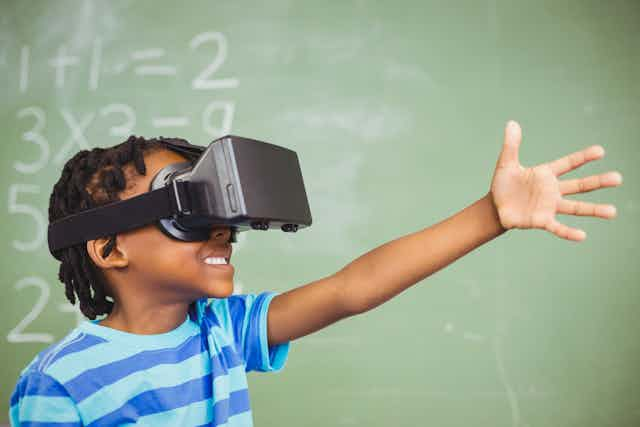Table of Contents
ToggleIntroduction
How Reading Is Being Changed by Virtual Reality In recent years, virtual reality (VR) has emerged as one of the most revolutionary technologies. Already, it has transformed industries like gaming, education, and even medical care. However, the literary industry is one of the most fascinating and somewhat surprising sectors where virtual reality is causing a stir.
Reading has always been a solitary, static activity, but with the introduction of virtual reality, literature is evolving into an immersive, interactive experience. Thanks to virtual reality (VR), readers may now enter the worlds of their favorite books, experience stories firsthand, and interact with them in ways that were previously unthinkable.
By providing new levels of involvement, creativity, and accessibility, virtual reality (VR) is revolutionizing how we read literature in 2024. This article examines the technologies, platforms, and advancements that are enabling virtual reality to transform literary encounters. Knowing how VR and literature interact can offer fascinating chances to interact with stories in a different way, whether you’re a writer, reader, or educator.
The Evolution of Literary Experiences: From Text to VR
How Reading Is Being Changed by Virtual Reality The traditional reading experience typically involves a physical or digital book that presents a linear narrative. The reader interprets the story through their imagination, guided by the words on the page.
Over the years, literature has evolved with technology, from the print revolution to the rise of eBooks and audiobooks. However, VR introduces an entirely new way to experience literature—one that immerses the reader in the story rather than just offering a passive experience.
In a VR-based literary experience, the reader becomes an active participant, navigating environments, interacting with characters, and sometimes even influencing the direction of the narrative. This level of immersion can transform how readers experience storytelling. Instead of imagining a scene, VR enables readers to walk through it, observe intricate details, and hear characters speak directly to them.
Read More
How Virtual Reality Enhances Reading
- Immersive Storytelling VR allows readers to enter the world of a book, experiencing the story in a much more visceral way. Imagine reading Alice in Wonderland and suddenly finding yourself in the whimsical landscape of Wonderland, surrounded by talking animals and magical scenery. Instead of merely picturing the setting in your mind, you can walk through it and interact with it.
- Interactive Narratives One of the most exciting aspects of VR in literature is the concept of interactive storytelling. Instead of just following a story along a set path, VR can give the reader control over the narrative. This opens the door to more dynamic, branching storylines where the reader’s actions impact the story’s direction.
- Enhancing Emotional Engagement VR’s immersive capabilities make it possible for readers to feel emotionally connected to characters and the world in a way that is difficult to achieve with text alone. When readers can see, hear, and interact with the characters in a 360-degree environment, the emotional stakes of the story are heightened. This kind of engagement can evoke powerful reactions, making readers feel as though they are living within the story.
- Creating New Genres The fusion of literature and virtual reality has led to the development of entirely new genres of storytelling. VR allows authors and creators to think beyond traditional storytelling methods, creating interactive, narrative-driven experiences that blend the best of literature, gaming, and cinema. These new genres offer exciting possibilities for creators and readers alike.
The Role of VR in Literature: Platforms and Tools
1. VR Storytelling Apps and Platforms
How Reading Is Being Changed by Virtual Reality Several VR platforms are dedicated to enhancing the literary experience by offering immersive storytelling options. These platforms allow users to engage with literature in ways that traditional formats cannot.
- Google Tilt Brush – Tilt Brush allows users to paint in 3D, offering creators a tool to bring their narratives to life in the VR space. Though not directly a storytelling app, Tilt Brush allows authors and artists to create 3D environments and scenes that can serve as a backdrop for immersive stories.
- The VR Museum of Fine Art – This platform allows users to explore artworks in virtual reality, and in some cases, literary works are accompanied by visual representations that enhance the narrative. For example, the museum offers the opportunity to explore famous works of fiction in immersive environments.
- Wander – While originally focused on exploration and travel, Wander allows users to visit and interact with famous literary landmarks. Readers can step inside scenes from their favorite novels or explore the setting of a book to gain new insights into the author’s vision.
2. Interactive VR Novels
The development of interactive VR novels is one of the most groundbreaking applications of virtual reality in literature. These novels allow readers to enter fully realized virtual environments, where they can interact with characters, make decisions, and influence the direction of the story.
- “The Invisible Man VR” – Based on the classic H.G. Wells novel, The Invisible Man VR allows players to experience the story from a new perspective. In this VR experience, players interact with the plot from the viewpoint of the invisible protagonist, adding an element of immersion and agency that standard literature cannot provide.
- “The Night Cafe VR” – This immersive VR experience is based on the famous painting by Vincent van Gogh and includes interactive elements inspired by the theme of isolation found in literature. Readers can explore the world inside the painting, which serves as a gateway to deeper narrative experiences.
3. Audiobooks and VR Integration
How Reading Is Being Changed by Virtual Reality In 2024, VR technology is also being integrated with audiobook services. Many audiobook apps are now offering VR features, allowing users to listen to books in virtual environments while engaging with visual elements that complement the audio.
- Audiobooks on Oculus – Platforms such as Audible are being adapted to work with VR headsets, providing an audio-based experience within virtual environments. By adding visual elements like virtual bookshelves or library settings, readers can immerse themselves in an audiobook experience that combines both auditory and visual storytelling.
Educational Applications of VR in Literature
1. Classroom Engagement
How Reading Is Being Changed by Virtual Reality For educators, VR has the potential to revolutionize how literature is taught and experienced in schools. Instead of simply reading a book and analyzing its themes, students can visit historical settings, interact with literary characters, and gain a deeper understanding of the text’s context and setting.
- Literary Field Trips in VR – With VR, students can take field trips to the settings of novels. Imagine visiting 18th-century London in a VR tour while reading Oliver Twist or exploring the fictional world of The Hobbit from inside the Shire. These experiences deepen comprehension and make the stories more relatable.
2. Accessibility for Diverse Learners
VR is also playing a key role in making literature more accessible for individuals with disabilities. For visually impaired readers, VR combined with auditory cues can create tactile, multisensory reading experiences. For those with hearing impairments, VR can provide subtitles or visual narratives to support a more immersive experience. The ability to personalize reading environments in VR also helps cater to readers with different learning styles and needs.
Read More
How VR Can Impact the Future of Publishing
How Reading Is Being Changed by Virtual Reality The fusion of VR and literature is still in its early stages, but the potential for future growth is limitless. As the technology becomes more refined and accessible, VR could become a mainstream tool in the publishing world.
- Virtual Book Launches and Author Events – Authors may host virtual reality book launches where readers can meet the characters of the book, explore its world, and interact with the author in a fully immersive environment.
- New Publishing Models – As VR becomes more integrated into the publishing world, it could lead to entirely new forms of book publishing. Publishers could release VR versions of books alongside traditional print editions, allowing readers to experience both the text and the virtual reality version of the story.

Conclusion
How Reading Is Being Changed by Virtual Reality Virtual reality is transforming the way we experience literature. By offering immersive, interactive, and sensory experiences, VR is bringing stories to life in ways that traditional books cannot.
Whether it’s stepping into the world of Alice in Wonderland, experiencing an interactive novel like The Invisible Man VR, or exploring the settings of famous works of literature, VR is changing the nature of storytelling itself.
In 2024, VR technology has already started to reshape the future of literature and reading. As the technology continues to evolve, we can expect even more innovations that will enhance our engagement with books, offer new creative opportunities for authors, and make literature more accessible to a wider range of audiences.
For book lovers, the integration of virtual reality offers a glimpse into the future of reading—one that is more immersive, interactive, and transformative than ever before.
Read More
FAQ
1. What is VR in literature?
VR in literature refers to the use of virtual reality technology to create immersive, interactive literary experiences. It allows readers to step inside the worlds of their favorite books, interact with characters, and experience the story from a first-person perspective.
2. How can VR enhance storytelling?
VR enhances storytelling by providing a 360-degree environment where readers can interact with the narrative, influence the plot, and emotionally connect with the characters. It creates a fully immersive experience that text alone cannot offer.
3. What are some popular VR literary experiences?
Some popular VR literary experiences include The Invisible Man VR, The Night Cafe VR, and VR adaptations of classic novels. These experiences allow readers to immerse themselves in the settings and perspectives of the stories.
4. Can VR be used in classrooms?
Yes, VR is increasingly being used in classrooms to enhance literature education. Students can take virtual field trips to the settings of novels, interact with characters, and gain a deeper understanding of literary themes and historical contexts.
5. Is VR in literature the future of reading?
While VR in literature is still developing, it offers exciting possibilities for the future of reading. As technology advances, VR could become a mainstream tool for enhancing the reading experience, offering new ways to engage with books and authors.
















